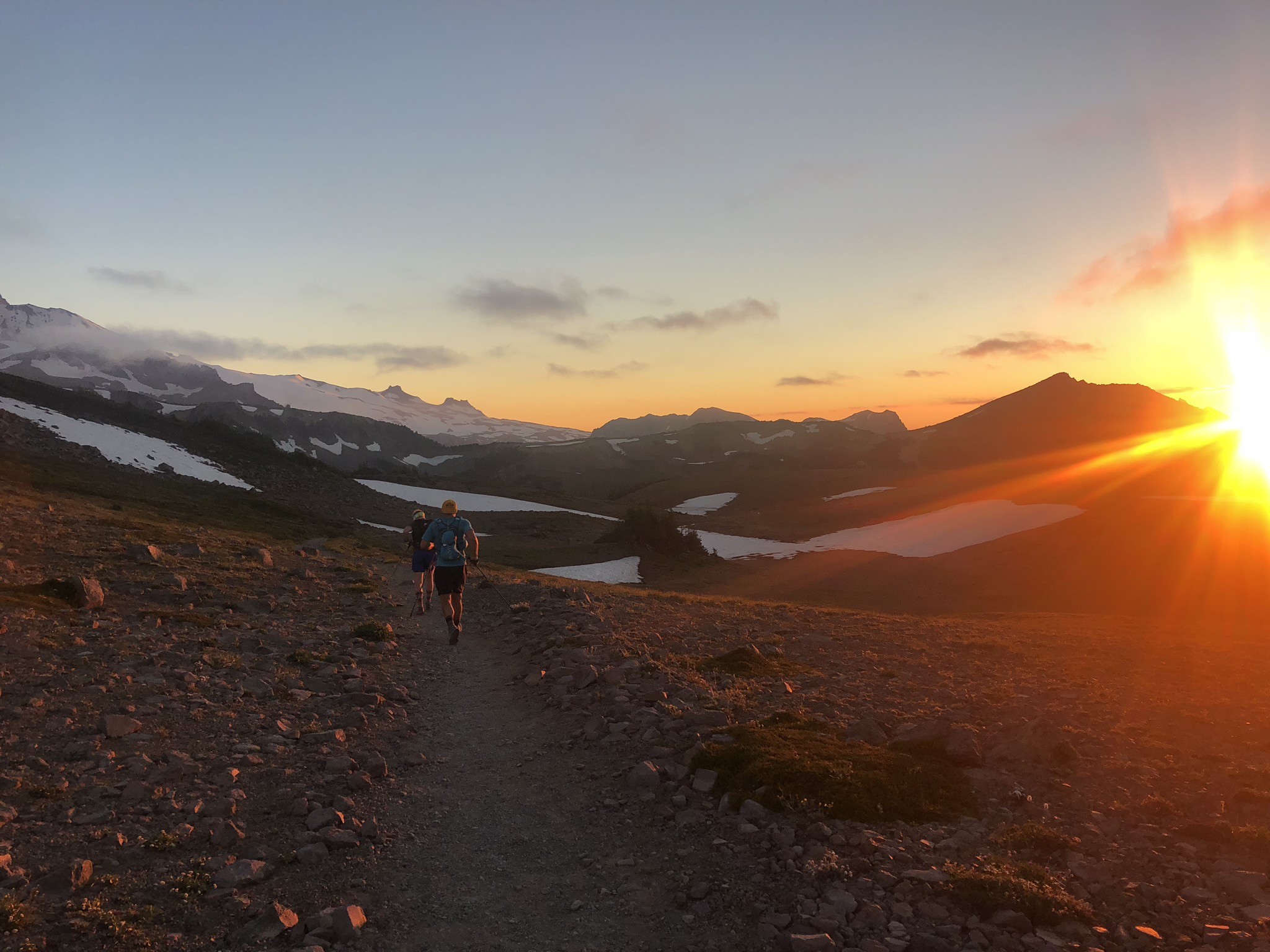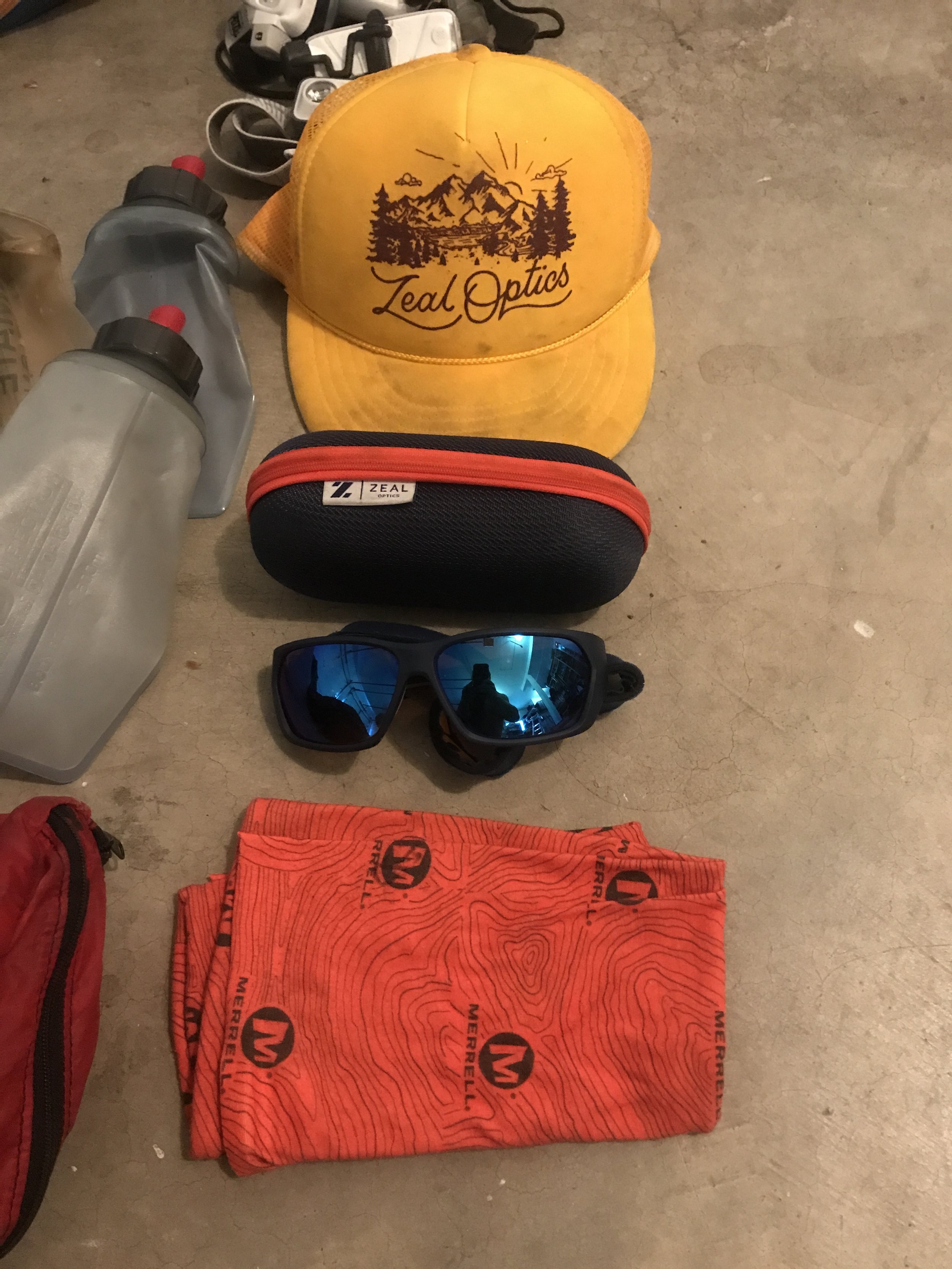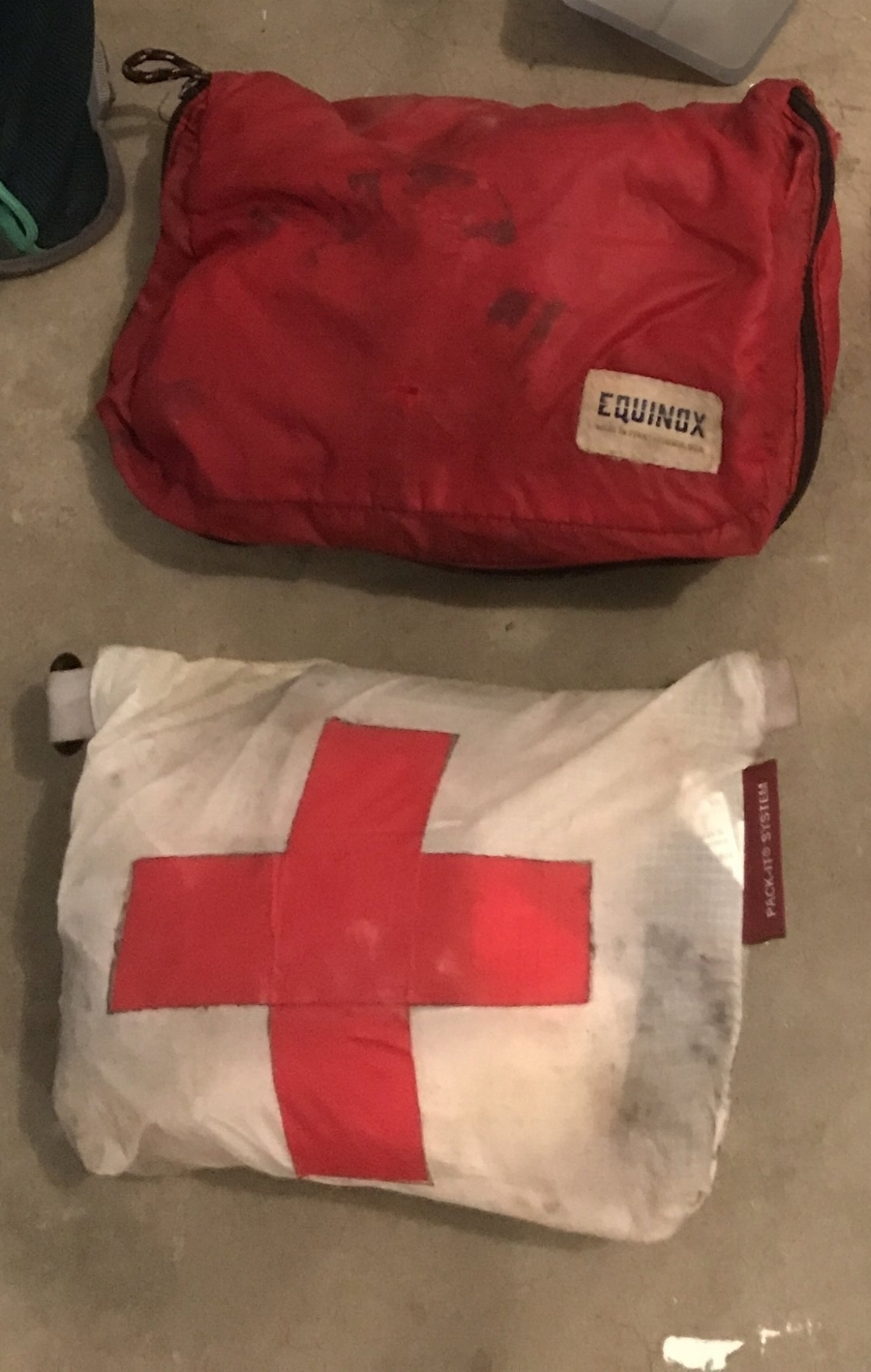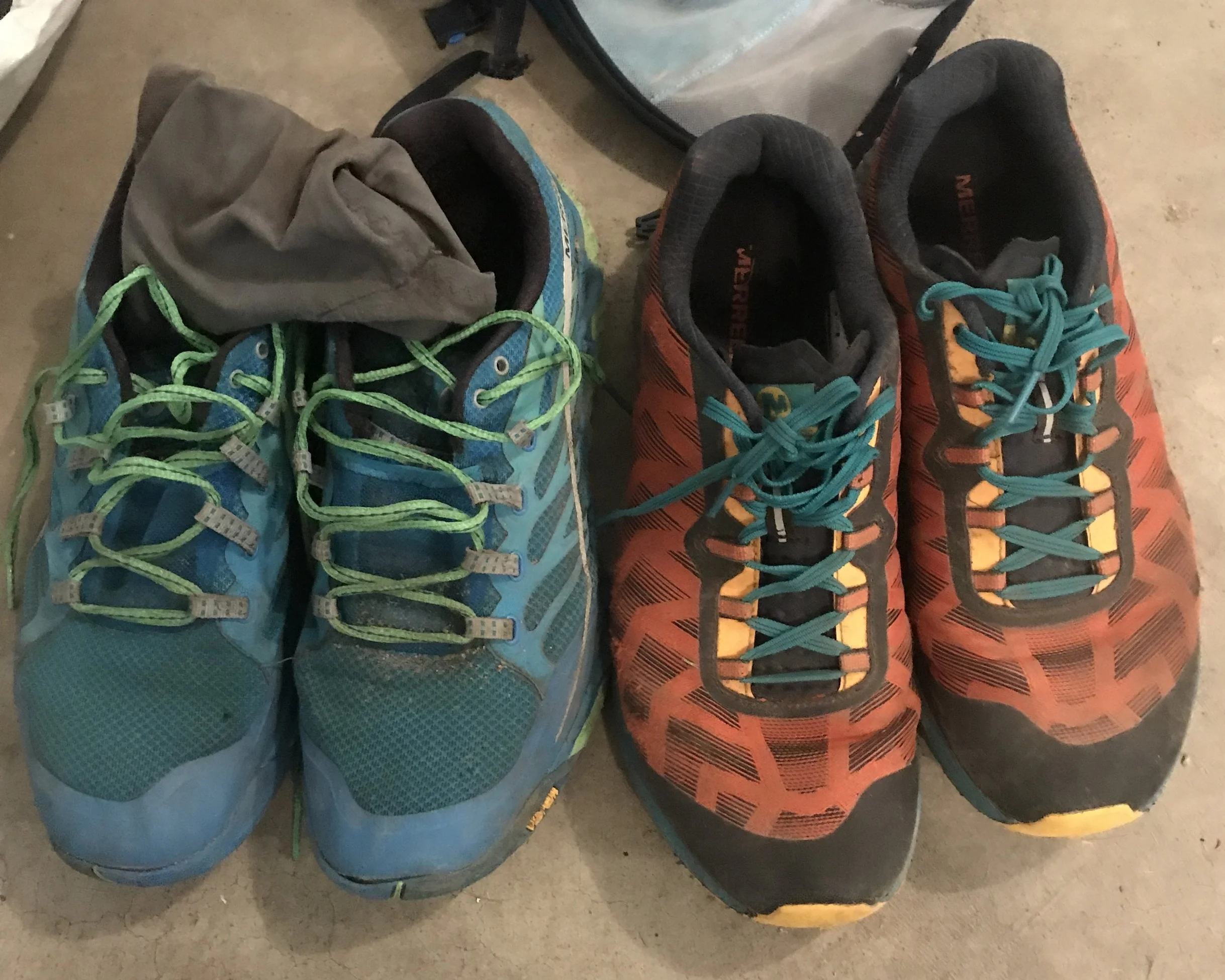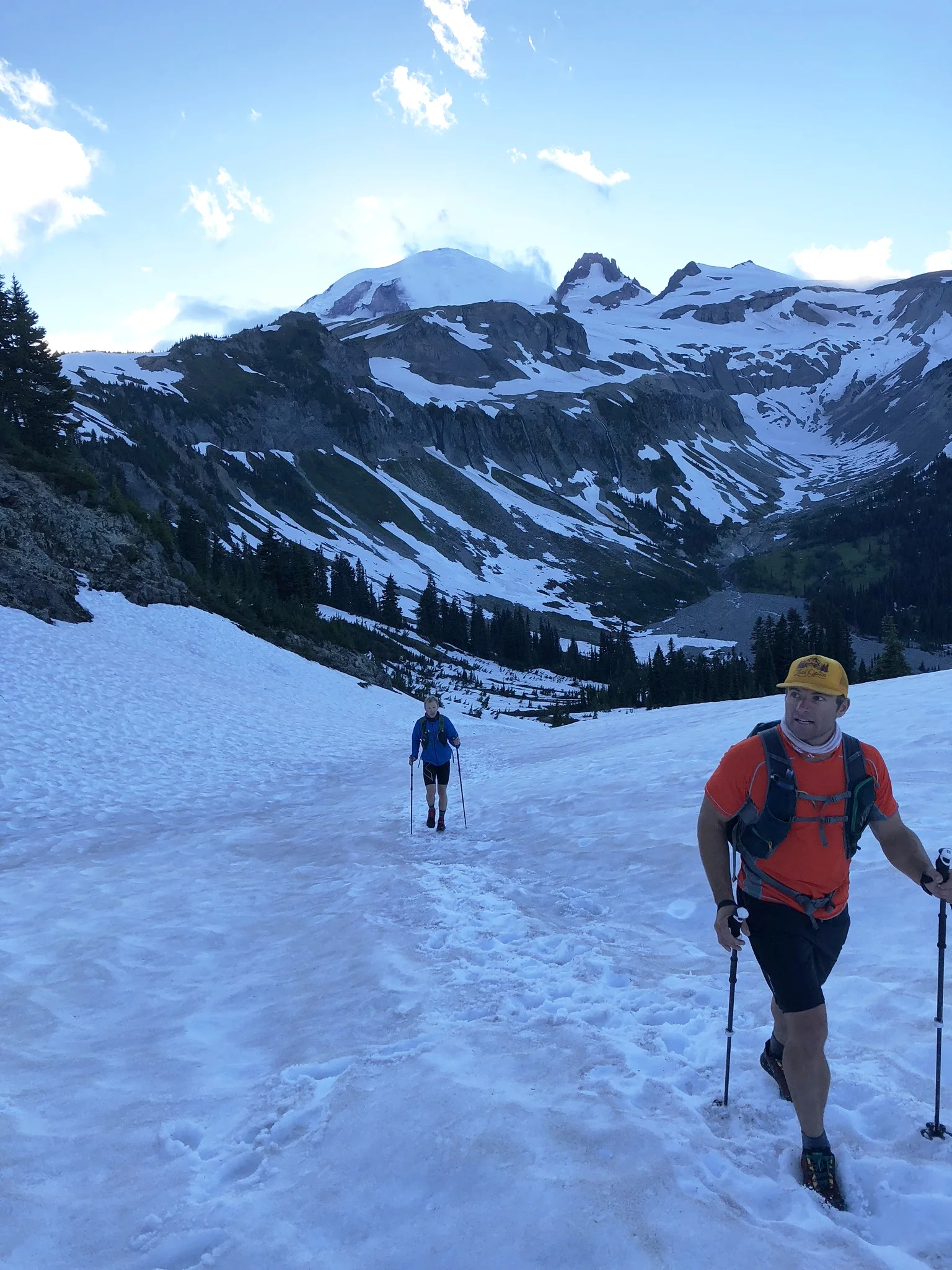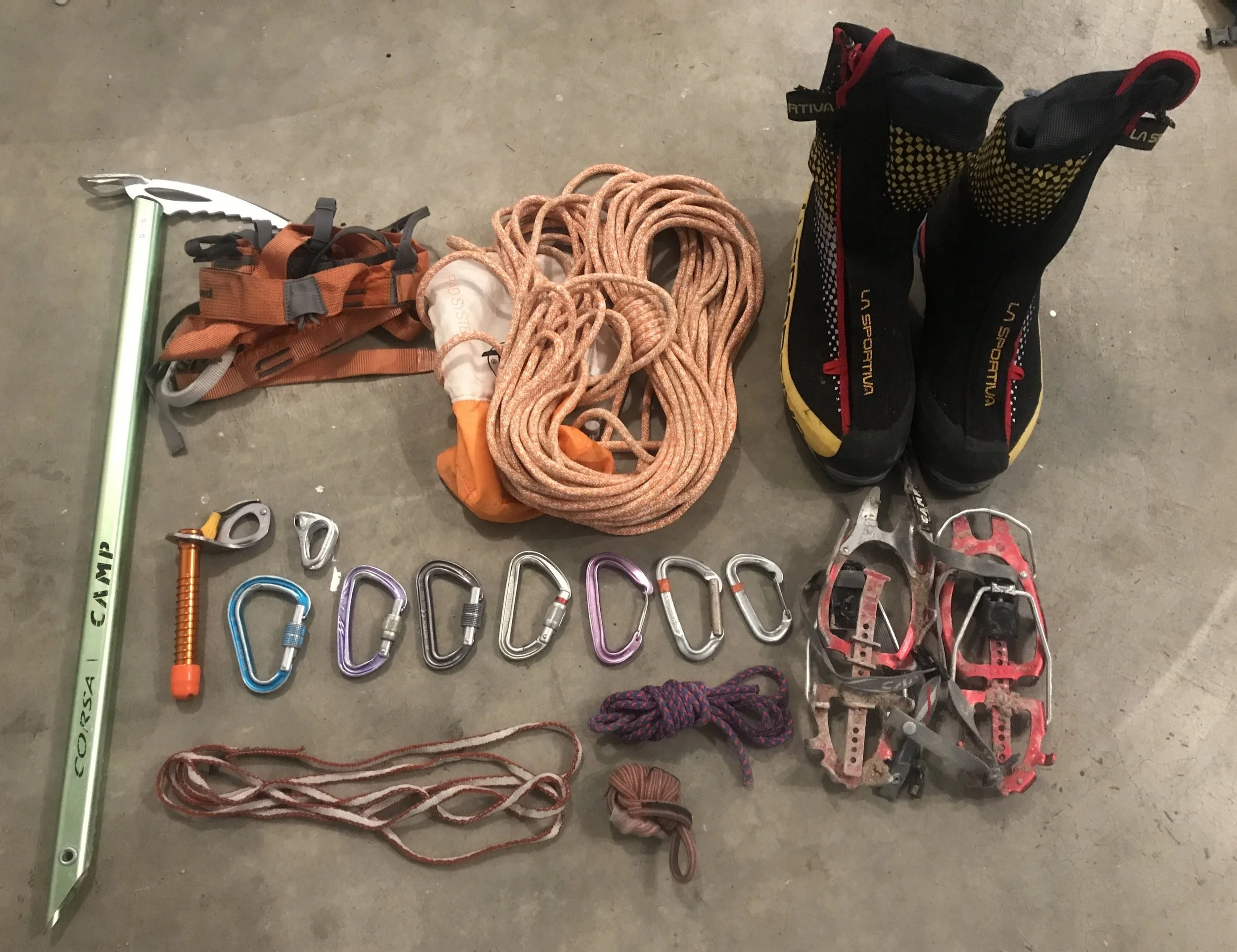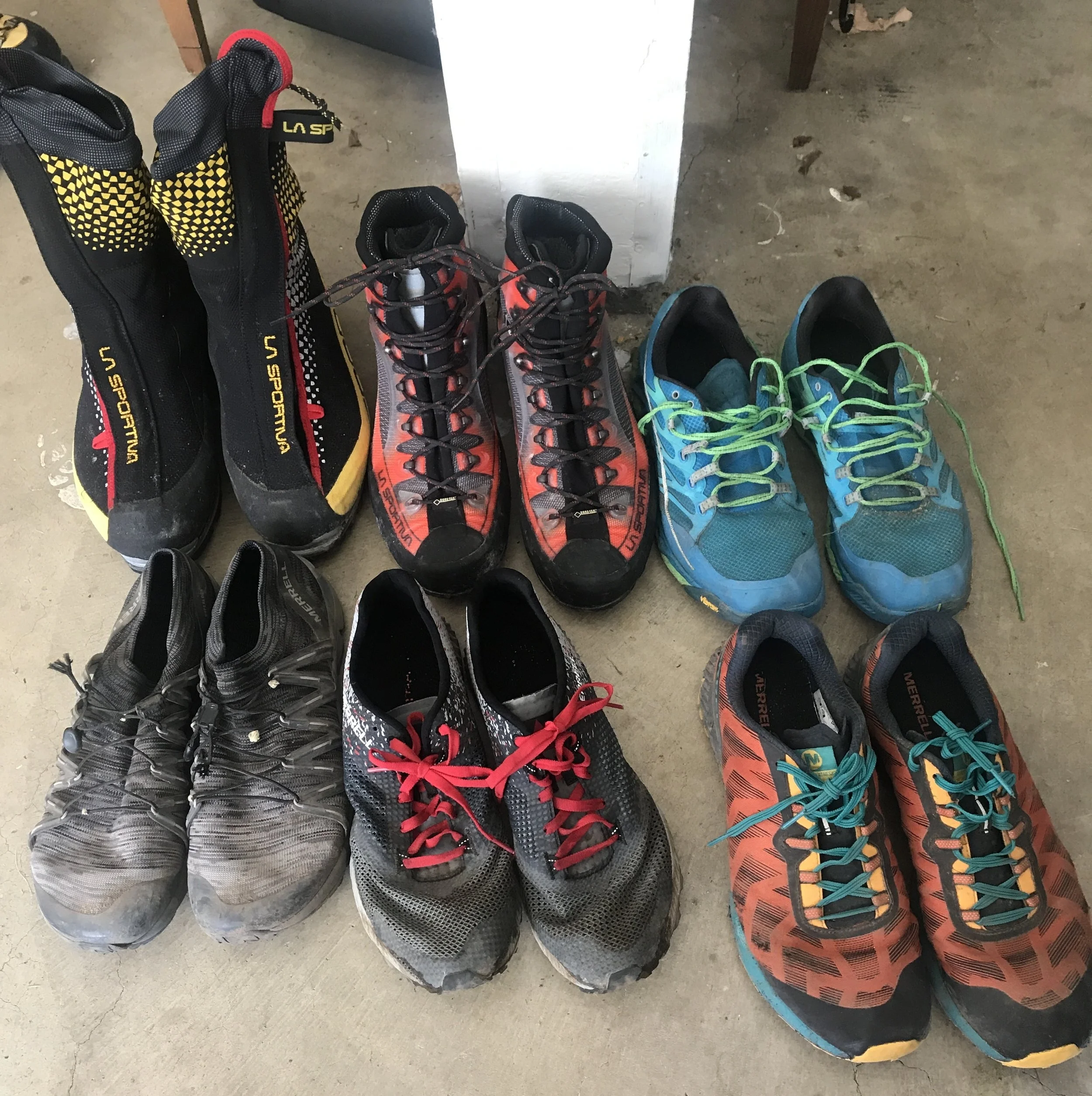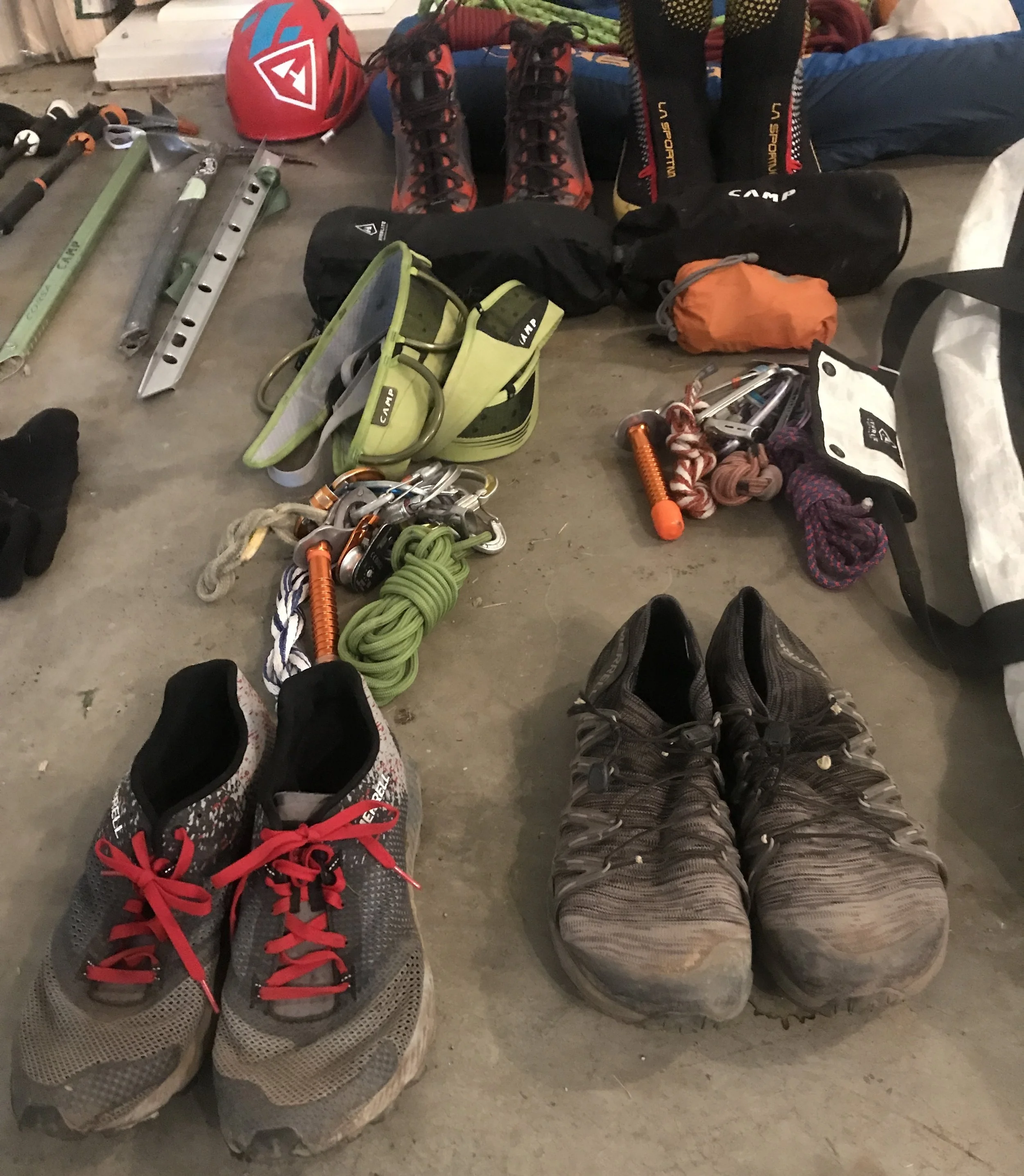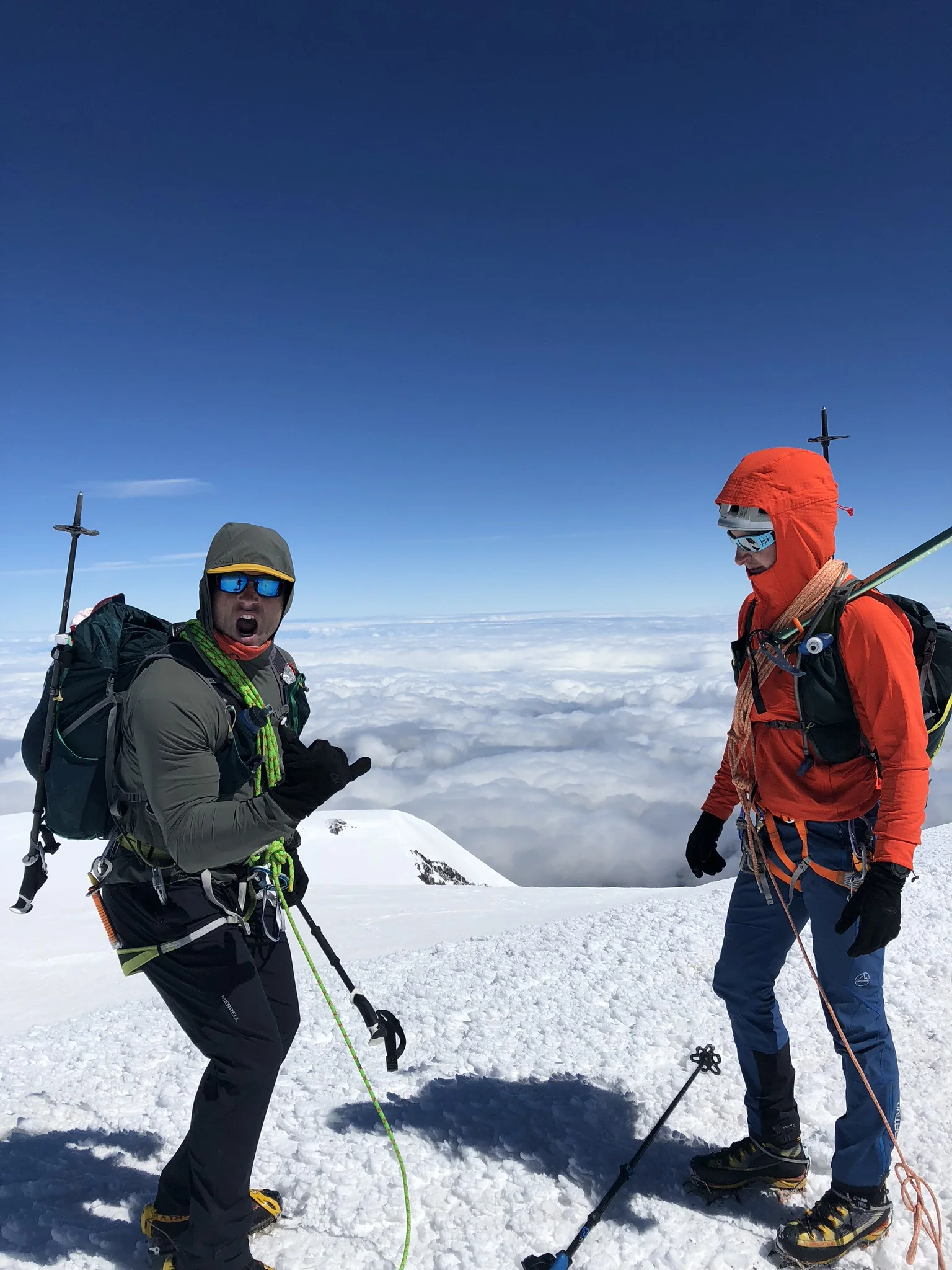Running into the second night along the Wonderland Trail during the Rainier Infinity Loop
During my self-supported speed effort on the Rainier Infinity Loop I was able to break the adventure into 4 sections and thus 4 gear kits.
For those of of you unfamiliar with the Rainier Infinity Loop, it is an all encompassing ultra-mountaineering adventure that takes you on a journey through Rainier National Park, climbing to the 14,411’ summit of the glaciated peak of Mt. Rainier not once but twice and circumnavigating the entire mountain by way of the iconic Wonderland Trail.
When we completed the adventure in 59 hours and 21 minutes, we started at the John Muir Steps at Paradise Trailhead. We started by climbing the south face of the mountain via the Disappointment Cleaver Route to the Summit of Mt. Rainier then descended to the North East via the Emmons Glacier to the White River Trailhead. Once at White River, we ran 30 Miles clockwise back to Paradise Trailhead. We grabbed our 2nd mountain kit and climbed Mount Rainier again via the same routes as before, then finished the loop by running the remaining 67 Miles of the Wonderland Trail counterclockwise back to the John Muir Steps, effectively tracing an “Infinity Loop” around Mount Rainier National Park. The Mount Rainier Infinity Loop covers 135+ miles and has over 47,000 feet of elevation gain.
If you are interested in the details, you can read all about my Infinity Loop adventure here.
Gear Carried for the Entire Adventure:
Baselayer
- 2XU Compression Shorts
- Merrell Synthetic T-Shirt
A lightweight hat, buff and good (glacier quality) sunglasses were essential to all legs of this adventure.
Headwear
- Mesh Trucker Cap - Zeal Optics
- 2x Merrell Buff
- Zeal Optics Caddis Sunglasses
Apparel & Layers
- Merrell Hyperlite Windshirt Layer
- Merrell VaporVent Trail Hardshell Jacket
Electronics & Navigation
- Map
- Suunto MC-II Compass
- iPhone 7+
- Gaia App with relevant maps downloaded on everyone's phone
- Garmin InReach Explorer+
- GPS Watch (we all had em, I used the Suunto Ambit 3 Peak, but we used a Fenix 3 to log the entire track)
First Aid & Repair Kit
Med Kit & Repair Kit
- 1x Roll Athletic Tape
- 8x Strips of K-Tape
- 1x ABD/Gauge Pad
- Painkillers [NSAIDs + Stronger stuff]
- 1x Ski Strap
- 6 feet of 3mm accesory cord
- 15 feet Duct Tape
- Leatherman Wave
- Emergency Headlamp (Petzl Mini)
- 2-Person Emergency Bivy/Blanket
- Albuterol Inhaler
- 3x 20mg Prednisone
Additional Food & Supplies
- 600 Emergency Calories (i.e. shot blocks and stinger waffles)
- Chapstick (doubled as lube if needed)
- MEG 100mg Caffeine Gum
- SunBum Zinc Sunscreen
- Mt. Rainier Climber's Permit
Mountain Kit #1
1st Ascent of Mt. Rainier (Up DC, Down Emmons)
Pack
- Fastpacking Vest [Ultimate Direction PastPack 35]
First Lap: Trango Cube & Merrell All Out Crush II
Footwear
- Red Trango Cube Gtx Mountaineering Boots
- Merrell All Out Crush II (for the final 5+ Mile run down to White River)
- Midweight Socks
Apparel & Layering
- Merrell Allpath, superlight softshell pant
- Merrell Tempro Featherless Down Jacket (w/ Compression Sack)
Gloves
- Light Windstopper Fleece Gloves
- Black Diamond Terminator Glove
- OR Goretex Overmitt (Emergency pair stuffed at bottom of pack)
Headwear
- Black Diamond Vapor Helmet
Lighting
- Black Diamond Cosmo Headlamp (w/ 3x Spare AAA Batteries)
Personal Technical Gear
- Harness [CAMP Air CR Evo]
- Crampons [Grivel Airtech Light - semi auto]
- Crampon Bag [Hyperlight Mountain Gear]
- Ice Axe [Grivel Air Tech Racing, 58cm]
- Cordelette
- Double Length Runner, 120cm [Mammut Dyneema]
- Prussic [Sterling Hollow block]
- 5x Locking Carabiners
- 2x Non-Locking Carabiners
- Petzl Tibloc
- Petzl Microtraxion
- Ice Screw [Petzl Laser Speed 13cm w/ plastic cap]
- 2x Trekking Poles [Black Diamond Traverse, Carbon Ski pole]
Team Technical Gear
- 30M Rope [Sterling 8mm Alpine]
- 30M Rope [Petzl RAD line]
- 1x Snow Picket [MSR]
Technical Gear for the first summit of Mt. Rainier
Fuel & Hydration (2.5L Water for Climb)
- 1.5L Bladder
- 1x 500ml UD Soft flasks
- 1x 500ml Salomon Soft flasks
- Food (1,800 Calories)
- 20 Electrolyte Pills
Trailrunning Kit #1
30 Mile Section of The Wonderland Trail
Pack
- Fastpacking Vest [Ultimate Direction PastPack 35]
Poles
- 2x Trekking Poles [Black Diamond Traverse, Carbon Ski pole]
Merrell All Out Peak & Gaiters (Left) I used for 67 Miles, Agility Synthesis Flex (Right) worn for the first 30 miles.
Lighting
- Petzl Nao Headlamp (w/ spare battery)
Footwear
- Merrell Agility Synthesis Flex
- Injinji Toe-Socks
Apparel & Layering
- Merrell Allpath Short
- Merrell Allpath Pants (carried over for next climb, and incase of cold weather)
- Merrell Adventure Travel Hybrid Jacket
UD soft bottles and the Katadyn BeFree Microfilter
Gloves
- Black Diamond Terminator Glove (carried over for next climb, and incase of cold weather)
- OR Goretex Overmitt (Emergency Pair Stuffed at bottom of pack)
Fuel & Hydration (1L Water)
- 1x UD 500ml Soft Flask
- 1x .6L Katadyn Filtration Softbottle
- Food (1,600 Calories)
- 16 Electrolyte Pills
Rocking Running Kit #1 during a rugged section of trail.
Mountain Kit #2
2nd Ascent of Mt. Rainier (Up DC, Down Emmons)
Pack
- Fastpacking Vest [Ultimate Direction PastPack 35]
I used the Black Diamond Cosmo (bottom, 160 lumens) for the first summit, then Petzl Nao (top, 575 Lumens) for eveything else.
Lighting
- Petzl Nao Headlamp (w/ spare battery)
Footwear
- Mountaineering Boots [G5]
- Merrell Bare Access Flex Knit
- Midweight Socks
Apparel & Layering
- Merrell Allpath Pant (available Spring 2019)
- Merrell Adventure Travel Hybrid Jacket
- Merrell MicrolitePuffer (w/ Compression Sack)
Gloves
- Merrell Windshell Thin Running Gloves
- Black Diamond Terminator Glove
- OR Goretex Overmitt (Emergency Pair Stuffed at bottom of pack)
Personal Technical Gear
- Harness [Black Diamond Couloir Harness]
- Crampons [CAMP XLC Nanotech, Full Auto]
- Ice Axe [CAMP Corsa, 70cm]
- Double Length Runner, 120cm [Mammut Dyneema]
- Short Prussic
- Longer 120CM Prussic Cord
- 4x Locking Carabiners
- 3x Non-Locking Carabiners
- Petzl Tibloc
- Ice Screw [Petzl Laser Speed 13cm w/ plastic cap]
- 2x Trekking Poles [Black Diamond Traverse, Carbon Ski pole]
Team Technical Gear
- 30M Rope [Petzl RAD line]
Mountain Kit #2
Fuel & Hydration (2.5L Water for Climb)
- 1.5L Bladder
- 1x 500ml UD Soft flask
- 1x .6L Katadyn BeFree Microfilter Softbottle
- Food (2,400 Calories)
- 20 Electrolyte Pills
Descending the Emmons Glacier with Mountain Kit #2
Trailrunning Kit #2
67 Mile Section of The Wonderland trail
Pack
- Running Vest [Ultimate Direction Adventure Vest 4.0]
Poles
- 2x Trailrunning Poles [Black Diamond UltraDistance Carbon]
Lighting
- Petzl Nao Headlamp (w/ spare battery)
Footwear
- Merrell All Out Peak
- Trail Gaiters
- Mid-weight Trail running socks
Apparel & Layering
- Merrell Allpath Short
- Merrell Adventure Travel Hybrid Jacket
Gloves
- Merrell thin fleece running glove with removable wind mitten
Fuel & Hydration (1L Water)
- 1x UD 500ml Soft Flask
- 1x .6L Katadyn Filtration Softbottle
- Food (5,200 Calories)
- 50 Electrolyte Pills
Just starting out the final 67 miles of Wonderland Trail in Running Kit #2
Gear Summary
Footwear
For the first lap up Mt. Rainier, I elected to wear lighter mountaineering boots (Trango Cube GTX) and carry a pair of light trail runners (Merrell All Out Crush 2) for the trail run out from Glacier Basin. I was happy with my decision and appreciated the rigid boot in the soft snow as we descended the Emmons glacier. Erik and Scott Bennett both wore a gaitored hybrid trail runner, but I don’t think that configuration would have sped up our times or made the climb more comfortable. I greatly valued the ability to change into comfortable trail runners and was glad I carried them up and over Rainier each time.
For the second lap, I elected to use an even more robust mountain boot, the G5. I chose this boot for a few reasons; a) I don’t own another pair of light mountaineering boots and b) I knew we would be moving at a much slower pace and was worried I might not be able to keep my core/extremities as warm as I could during our previous ascent. I think, given our weather during this particular ascent, I could have easily used lighter boots, but it was nice to have the G5s (850g) as an insurance policy.
For the running on the Wonderland Trail I wore the Merrell Agility Synthesis Flex for the first 30 Miles. These have a pretty knobby tread which ended up being quite useful on the snow and mud we encountered on the first section. I could have continued on in these for the duration, but because I left them at Paradise, I had a pair of the Merrell All Out Peak waiting for me at White River. These trail runners, combined with a light tail gaiter were a fantastic combination for the final 67 miles of the Infinity Loop. The shoes are grippy and provide more than sufficient cushioning for that type of distance that included sustained, pounding downhill sections.
The complete footwear arsenal
Apparel & Layers:
I wore a pair of 2XU compression shorts the entire time, and would follow this strategy in the future. For bottoms, I wore an incredibly light pair of the Merrell Allpath pant for my time on Rainier, then switched to the Allspath Short for the Wonderland Trail. Both the pants and shorts are really lightweight and pair well with the slightly thicker compression short.
I carried a robust puffy jacket with me to summit, both times. Even though I never took my insulated jackets out of the stuff sacks, I like knowing I can get inside of a cocoon in the event of weather, injury or equipment failure. The extra layer goes a long way in the event of an emergency.
I carried a very light windlayer (Merrell Hyperlite) the entire time. I wore it for most of my time on Mt. Rainier and for several colder sections of the Wonderland trail.
A hardshell jacket (Merrell Vaporvent Trail Jacket) was also with me at all times in case of inclement weather. Again, another piece of gear I wouldn’t leave behind.
Head + Neck + Face
I never carried a knit hat or balaclava, however I did carry 1x buff for the Wonderland Trail and two when I was on Rainier. I find that the buffs, combined with a trucker hat and hood, provide more than enough head, neck and face warmth given the time of year.
I wore the Zeal Optics Caddis for the entire journey. I found the lens to be great for glacier travel with frames that were still breathable enough for trail running the Wonderland Trail.
We applied zinc/sunscreen quite regularly, but I missed a few spots and torched my lower lip. I’d be more aware of that next time.
Gloves
For each lap up Mt. Rainier I had a light glove, a medium weight and an emergency gore-tex mitten shell that could worn over the other gloves. For the first lap, I wore a pair of windstopper fleece gloves the entire time, but they were absolutely soaked by the time I reached White River. I carried the (unused) BD Terminators and Outdoor Research GoreTex Mittens back around to Paradise and used them on the 2nd climb. For the final Wonderland section, I carried a light pair of Merrell running gloves with a removable wind mitten, but never ended up needing them.
Glove Quiver. I wore every pair, with the exception of the OR overmitts.
Packs
The Ultimate Direction FastPack 35 (top), Adventure Vest 4.0 (Bottom), and the Hyperlite Mountain Gear Duffle is what I used to lug everything around (just out of picture)
For both Rainier ascents and the 30 Mile Wonderland Section I wore Ultimate Direction’s new FastPack 35. It fit everything we needed for the climb (including ice axe, technical gear and a 30M climbing rope) and allowed for a tight snug fit that kept the vest/pack in place when we were moving quick. I’m also a huge fan of the bottle holders up front, allowing for quicker stops when refilling water bottles. I did not weigh my pack at the start of the Rainier summit, but I estimate it to have been around 25lbs. Fortunately, our packs became progressively lighter throughout the Infinity Loop. It was also nice having the extra (35L) volume for that final stretch of trail coming down Rainier, as I would switch to trail runners and stow my mountain boots inside my pack.
For the final 67 mile leg of the Wonderland trail, I stripped my gear down to the absolute minimum and switched to the UD Adventure Vest 4.0. This is the 3rd version of the Adventure Vest that I have owned and I’ve been a big fan. Because we had so much food (26 hours worth) to start the adventure, I found that when I would drink the water in my front bottle holders (thus, lightening the front load) I would get significant chafing on my neck. I could solve this by pulling the rear load closer to my back, and moving my filter bottle to the front. It took me a few hours to figure out the balance. Aside from that, both packs worked exceptionally well.
Technical Gear
Side by side: Mountain Kits
For the first lap we had what I would define as a very sufficient glacier travel system for a party of 3. We carried one picket for the team and we all had robust trekking poles in addition to our ice axes. We also had enough rope to perform the drop-c loop if needed during crevasse rescue on either end of the rope team.
On my second lap, it was just a team of 2 and I trimmed down the rack. We made the decision to carry mostly “self-rescue” gear, including an ultralight ice screw each. I left the microtraxion and picket behind, as well as our 2nd 30M rope, carrying only a single 30M Petzl Rad Line. The set-up was much lighter, but it would have been significantly more involved if we had to employ any rescue systems while on the mountain.
Headlamps
I carried a light Black Diamond Cosmo headlamp (160 Lumens, 90g) for the first summit over Rainier, as I knew we wouldn’t need much light. I carried the Petzl Nao (575 Lumens, 187g) with an extra battery for all other sections. The bright illuminating power of the Nao made a huge difference in being able to keep a steady pace throughout the night, especially on the sustained downhills. The extra lumens are certainly worth the weight, and helped us really move well on the downhill sections when we were tired.
Electronics & GPS
I carried the Garmin InReach which allowed our position to be tracked, the option to communicate via the satellite messenger, and lastly as a backup GPS source.
Our primary source of navigation was through the Gaia app that each of us had downloaded on our personal phones. We used this app extensively. Please note that we all pre-downloaded the appropriate maps and GPX track prior to starting.
We all used different GPS watches to track time and elevation but Sam set his Garmin Fenix 3 on the most accurate setting and charged it on the go with an external battery track. His watch documented what we believe to be the most accurate GPS account of the Rainier Infinity Loop
Most Important Pieces of Gear
Zeal Optics Caddis Sunglasses
Rocking my first Mountain kit for the first summit of Rainier - Including the Zeal Caddis and Merrell Hyperlight Windshirt
This was my first time on a glacier for a prolonged period of time without proper “glacier glasses.” I wanted something that would provide solid coverage and protection but also allow good airflow while trail running through humid/dense forest. They were on my head for 59 hours and performed really well.
Merrell Hyperlite Windshirt
I carried this windproof layer on every single leg of the journey. It’s incredibly light and packable. Most importantly, it packs a punch when you need a little relief from the elements, either while we stopped to refill bottles or when the sun and winds picked-up high on Rainier. (note: I was testing out this piece and it will be available spring 2019)
Ski Strap
This is an invaluable piece of any adventurers med/repair kit. A ski strap was what we used to fix my crampon when the toe-bail snapped high on the Emmons Glacier. Without such a solid temporary solution our time on the that descent would have been significantly lengthened and my security on the mountain compromised.
Katadyn BeFree .6L microfilter
This microfilter was a game changer for us on the trails. I was very impressed that we could easily carry as little water as we did during the 100 Mile voyage on the remote Wonderland Trail. It’s one of the fastest filters I’ve ever used and doubles as half of my carrying capacity. We each carried one and were able to limit our water stops to just a few short minutes. During each refill we would finish all our water, filter and chug one BeFree bottle, filter and fill our 2nd soft flask, then fill one last BeFree bottle before moving onward. Thanks again to Scott Bennett who tipped us off to this filter before we headed out to Seattle.
Gear explosion in a Seattle garage after the Infinity Loop.
There are more than one way to skin a cat, especially when it comes to gear selection for an objective like the Rainier Infinity Loop. I was happy with the choices we made for our adventure, and likely wouldn't make any major changes for a future attempt.
If you have any questions about the gear we used, please don't hesitate to reach out.

